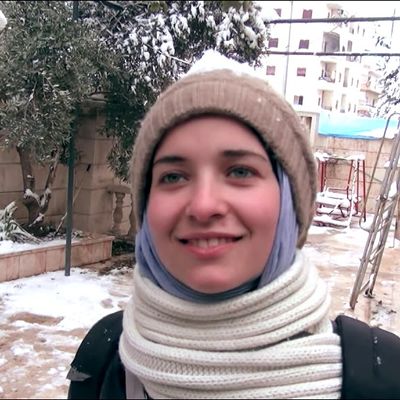
A society is measured by how it treats the most vulnerable, which is why images of suffering or injured children feature so prominently in accounts of human-rights abuses: Even the most calloused or bigoted onlooker has a tough time saying, “Well, they brought this on themselves.” (Offered an opportunity to scold kids in cages at the border, our vice-president wisely opted to blame the Democrats.) Deaths of children are at the heart of Waad al-Kateab and Edward Watts’s first-person documentary of the siege of Aleppo, For Sama — Sama being Waad’s baby daughter, whose existence haunts Waad as she films her husband (one of the few doctors remaining in East Aleppo) as he attempts to save yet another bomb-mangled child. Watching the film, I felt it would be an act of cowardice to look away from what Waad was showing us. I trusted that this wasn’t just propaganda — that I was being asked by a mother to bear witness.
Waad and Watts touch only fleetingly on the larger context, but don’t expect For Sama to account for Putin’s aim in lending war planes to Bashar al-Assad or Assad and Putin’s decision to target civilians and hospitals with barrel bombs and chlorine gas. This is a movie of close-ups.
At the outset, Waad explains (to us, to her daughter in the future) that she came to Aleppo to go to university and stayed when the revolt against Assad flowered, falling in love with a doctor (Hamza al-Kateab) who was also a political activist. Footage from the years-long stalemate (pre-Putin), in which much of Aleppo was controlled by revolutionaries, suggests a kind of giddiness in simply living a “normal life” among brave, like-minded idealists. (Waad acknowledges the Islamist revolutionaries who committed their own atrocities but argues that their crimes were nothing compared with Assad’s.) That giddiness extends even to the onset of the final, months-long siege in 2016, when the bombings begin — then ends abruptly with the deaths of two members of Waad and Hamza’s posse, seen smiling and laughing seconds before. Like that, the horror is real. Much of the film takes place inside the hospital where, by the end, 890 operations were performed in 20 days.
For Sama is also for the two stunned little boys who weep over their brother (“We told him to come inside!”) and quiver nearby as their mother picks up the dead, wrapped child and carries him off, screaming, “Don’t take him from me! I won’t forgive you if you do!” It’s for the little boy who asks his father to tell him the story yet again of the building on which a bomb fell — the Aleppo version of “Goldilocks and the Three Bears.” It’s for the young child of Waad’s best friend, who says, “I want to be an architect so I can rebuild Aleppo.” It’s for the baby born via Caesarean without a pulse after its mother is dragged from the rubble, the child plainly, irremediably dead. Until … It should be for the girl who lies still while her mother screams at her to wake up and her father cries that they were only on the street, trying to escape the bombings, when the last bomb fell, for her. Here is a testament to the movie’s power: One of its less disturbing images is of a baby dead amid the debris, because Waad says, in voice-over, “I envy this boy’s mother. At least she died before she had to bury her child.” A mercy, indeed.
For Sama doesn’t feel like raw footage — it has been carefully shaped, with a bit of movie-ish suspense during the final hours, when the last of the families in East Aleppo were told they could surrender to the regime but were fired on anyway. The ending is a little fancy for my taste — a montage of the good times and an overhead shot of Waad and her baby walking through the rubble. Of course, For Sama isn’t for me, who watched helplessly from afar along with millions of others (including Obama’s distraught U.N. envoy, Samantha Power) as Aleppo was obliterated. It’s for that young architect of tomorrow, and, of course, Sama.
*A version of this article appears in the July 22, 2019, issue of New York Magazine. Subscribe Now!


